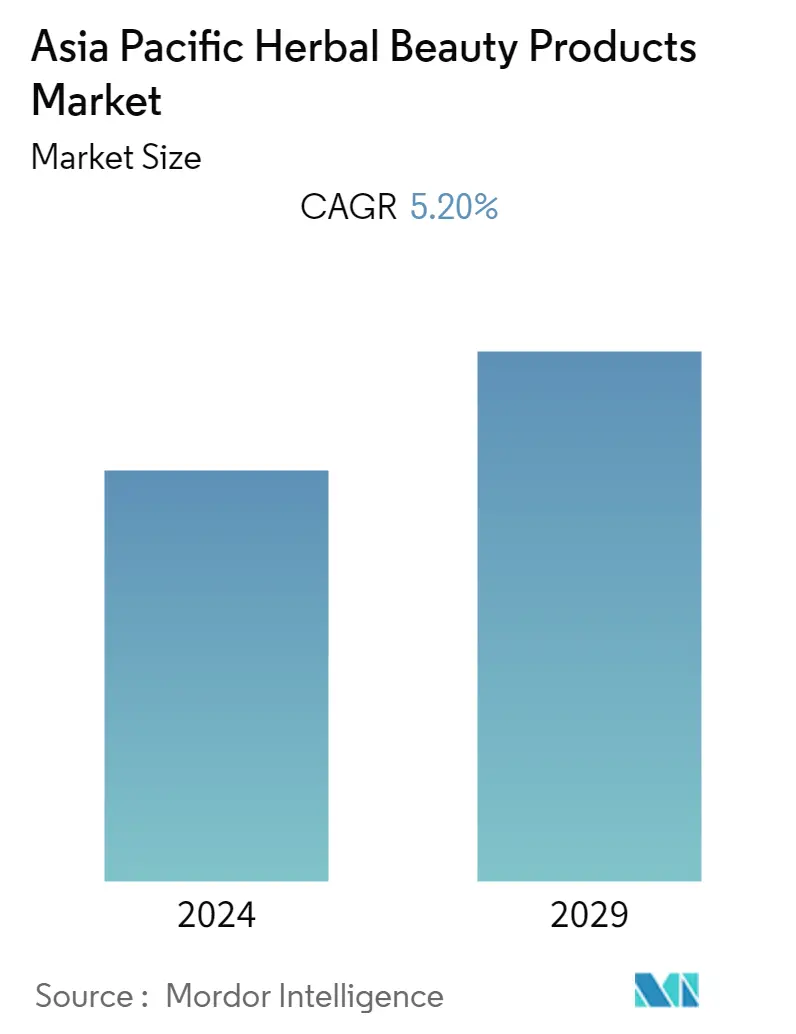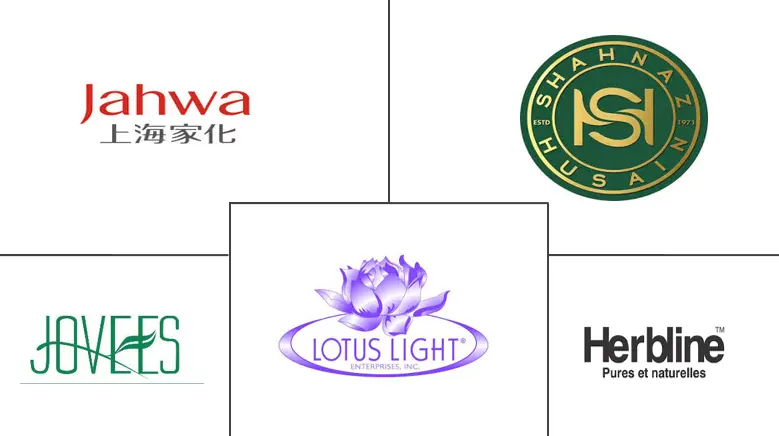Market Size of Asia Pacific Herbal Beauty Products Industry

| Study Period | 2019 - 2029 |
| Base Year For Estimation | 2023 |
| Forecast Data Period | 2024 - 2029 |
| Historical Data Period | 2019 - 2022 |
| CAGR | 5.20 % |
| Market Concentration | Medium |
Major Players
*Disclaimer: Major Players sorted in no particular order |
APAC Herbal Beauty Products Market Analysis
The Asia Pacific herbal beauty products market is projected to grow at a CAGR of 5.2% during the forecast period 2020-2025
- Consumer preference is shifting towards organic as well as herbal products, owing to increasing awareness regarding the adverse effects of chemicals on health as well as the environment. Consumers are inclined towards product formulated with botanical extracts such as essential oils, antioxidants, and natural coloring snd fragrance additives.
- The herbal beauty products market in the Asia Pacific is projected to expand at a considerable pace during the forecast period due to a rise in awareness regarding the advantages of herbal ingredients, rise in per capita income, and rapid urbanization. Countries such as India, Vietnam, Indonesia, the Philippines, and Malaysia are shifting from chemical-based cosmetic products to herbal skincare products.
- Additionally, players operating in the market are developing and launching new products to meet consumer demand, which is diversified based on geography and culture. For instance, in April 2019, a new product range of Herbal Essences was launched in India. The products offered are formulated with natural ingredients derived from strawberry, aloe vera, green tea, cucumber, and others.
- However, factors such as the limited supply of raw material used to prepare cosmetics and higher cost of herbal beauty products are likely to hamper the herbal beauty products market.
APAC Herbal Beauty Products Industry Segmentation
The Asia Pacific herbal beauty products market is segmented by product type that includes skincare products, hair care products, makeup and color cosmetics, fragrances, and other product types. Based on the distribution channel, the market is divided into supermarket/hypermarket, convenience stores, specialty stores, online stores, and other distribution channels. Also, the study provides an analysis of the herbal beauty products market in the emerging and established markets across the Asia Pacific, including China, Japan, Australia, India, and Rest of Asia Pacific.
| By Product Type | |
| Skin Care Products | |
| Hair Care Products | |
| Makeup, and Color Cosmetics | |
| Fragrances | |
| Other Product Types |
| By Distribution Channel | |
| Supermarket/Hypermarket | |
| Convenience Stores | |
| Specialty Stores | |
| Online Stores | |
| Other Distribution Channels |
| By Country | |
| China | |
| Japan | |
| Australia | |
| India | |
| Rest of Asia Pacific |
Asia Pacific Herbal Beauty Products Market Size Summary
The Asia Pacific herbal beauty products market is experiencing a significant transformation, driven by a growing consumer preference for organic and herbal products. This shift is largely due to increased awareness of the negative impacts of chemical-based products on health and the environment. Consumers are increasingly drawn to products containing botanical extracts, such as essential oils and natural additives, which are perceived as safer and more beneficial. The market is expected to expand steadily, fueled by rising awareness of the benefits of herbal ingredients, increasing per capita income, and rapid urbanization in countries like India, Vietnam, Indonesia, the Philippines, and Malaysia. These factors are encouraging a transition from chemical-based cosmetics to herbal alternatives, with companies responding by developing and launching new products tailored to diverse consumer preferences across different regions.
The market for herbal beauty products in the Asia Pacific region is characterized by a competitive landscape, with numerous domestic and multinational companies vying for market share. The shampoo segment, in particular, is anticipated to witness robust growth due to its maturity, affordability, and innovation in the male grooming category. The demand for herbal hair care products, which utilize ingredients like coconut oil, sunflower oil, and neem, is on the rise, supported by the increasing awareness of personal appearance across all age groups. Key players in the market are focusing on strategic initiatives such as mergers, acquisitions, and partnerships to enhance their brand presence and meet consumer expectations. Companies like Shanghai Jahwa United Co. Ltd, Shahnaz Husain Group, and Lotus Light Enterprises, Inc. are leading the charge in this competitive market, emphasizing sustainability and the quality of their raw materials to attract environmentally conscious consumers.
Asia Pacific Herbal Beauty Products Market Size - Table of Contents
-
1. MARKET DYNAMICS
-
1.1 Market Drivers
-
1.2 Market Restraints
-
1.3 Porter's Five Forces Analysis
-
1.3.1 Threat of New Entrants
-
1.3.2 Bargaining Power of Buyers/Consumers
-
1.3.3 Bargaining Power of Suppliers
-
1.3.4 Threat of Substitute Products
-
1.3.5 Intensity of Competitive Rivalry
-
-
-
2. MARKET SEGMENTATION
-
2.1 By Product Type
-
2.1.1 Skin Care Products
-
2.1.2 Hair Care Products
-
2.1.3 Makeup, and Color Cosmetics
-
2.1.4 Fragrances
-
2.1.5 Other Product Types
-
-
2.2 By Distribution Channel
-
2.2.1 Supermarket/Hypermarket
-
2.2.2 Convenience Stores
-
2.2.3 Specialty Stores
-
2.2.4 Online Stores
-
2.2.5 Other Distribution Channels
-
-
2.3 By Country
-
2.3.1 China
-
2.3.2 Japan
-
2.3.3 Australia
-
2.3.4 India
-
2.3.5 Rest of Asia Pacific
-
-
Asia Pacific Herbal Beauty Products Market Size FAQs
What is the current Asia Pacific Herbal Beauty Products Market size?
The Asia Pacific Herbal Beauty Products Market is projected to register a CAGR of 5.20% during the forecast period (2024-2029)
Who are the key players in Asia Pacific Herbal Beauty Products Market?
Shanghai Jahwa United Co., Ltd, Shahnaz Husain Group, Lotus Light Enterprises, Inc., Jovees and Herbline are the major companies operating in the Asia Pacific Herbal Beauty Products Market.

